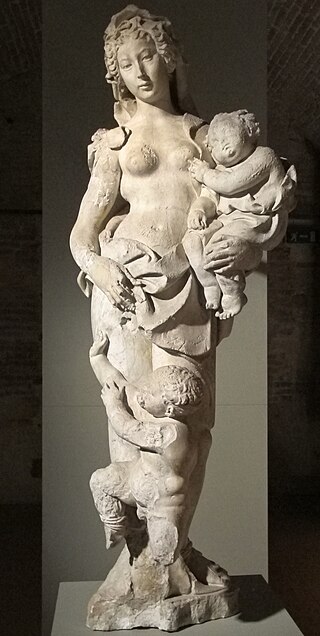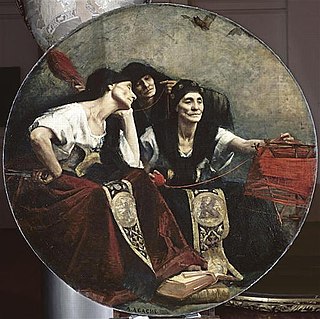Related Research Articles

Aulus Gellius was a Roman author and grammarian, who was probably born and certainly brought up in Rome. He was educated in Athens, after which he returned to Rome. He is famous for his Attic Nights, a commonplace book, or compilation of notes on grammar, philosophy, history, antiquarianism, and other subjects, preserving fragments of the works of many authors who might otherwise be unknown today.

Acca Larentia or Acca Larentina was a mythical woman, later a goddess of fertility, in Roman mythology whose festival, the Larentalia, was celebrated on December 23.

In Roman mythology, the Camenae were originally goddesses of childbirth, wells and fountains, and also prophetic deities.
In ancient Roman religion and myth, Nerio was an ancient war goddess and the personification of valor. She was the partner of Mars in ancient cult practices, and was sometimes identified with the goddess Bellona, and occasionally with the goddess Minerva. Spoils taken from enemies were sometimes dedicated to Nerio by the Romans. Nerio was later supplanted by mythologized deities appropriated and adapted from other religions.
In Roman mythology, Postverta or Postvorta was the goddess of the past and one of the two Carmentes. They were companions of the goddess Carmenta, and probably embodied her aspects as the goddess of the past (Postvorta) and the future.
Vatican Hill is a hill located across the Tiber river from the traditional seven hills of Rome, that also gave the name to Vatican City. It is the location of St. Peter's Basilica.

Cornelius Nepos was a Roman biographer. He was born at Hostilia, a village in Cisalpine Gaul not far from Verona.
Carmentalia was the two feast days of the Roman goddess Carmenta. She had her temple atop the Capitoline Hill. Carmenta was invoked in it as Postvorta and Antevorta, epithets which had reference to her power of looking back into the past and forward into the future. The festival was chiefly observed by women.

Nona was one of the Parcae, the three personifications of destiny in Roman mythology, and the Roman goddess of pregnancy. The Roman equivalent of the Greek Clotho, she spun the thread of life from her distaff onto her spindle. Nona, whose name means "ninth", was called upon by pregnant women in their ninth month when the child was due to be born.
In ancient Roman religion, Averruncus or Auruncus is a god of averting harm. Aulus Gellius says that he is one of the potentially malignant deities who must be propitiated for their power to both inflict and withhold disaster from people and the harvests.

In ancient Greek religion and myth, the Anemoi were wind gods who were each ascribed a cardinal direction from which their respective winds came, and were each associated with various seasons and weather conditions. They were the progeny of the goddess of the dawn Eos and her husband, the god of the dusk, Astraeus.
Marcus Porcius M. f. M. n. Cato Salonianus was the younger son of Cato the Elder, and grandfather of Marcus Porcius Cato Uticensis, also known as "Cato the Younger".
Lex Aebutia de formulis was a law established in ancient Rome in around 150 BC, though the date is quite uncertain.
Aulus Hostilius Mancinus was consul of the Roman Republic, together with Aulus Atilius Serranus, in 170 BC. He had been an urban praetor in 180 BC. When he was consul he was given the command of the Third Macedonian War for that year.
In ancient Roman religion, Vagitanus or Vaticanus was one of a number of childbirth deities who influenced or guided some aspect of parturition, in this instance the newborn's crying. Some sources relate it to the Latin noun vagitus, "crying, squalling, wailing," particularly by a baby or an animal, and the verb vagio, vagire. Vagitanus has thus been described as the god "who presided over the beginning of human speech," but a distinction should be made between the first cry and the first instance of articulate speech, in regard to which Fabulinus was the deity to invoke. Vagitanus has been connected to a remark by Pliny that only a human being is thrown naked onto the naked earth on his day of birth for immediate wails (vagitus) and weeping.
The Moles are goddesses who appear in an ancient Roman prayer formula in connection with Mars. The list of invocations given by Aulus Gellius pairs a god's name with a feminine nominative noun that personifies a quality or power of the god (Moles Martis, "Moles of Mars"). These pairings are often taken as "marriages" in the anthropomorphic mythological tradition. An inscription records a supplicatio Molibus Martis, supplication for the Moles of Mars.

Gnaeus Gellius was a Roman historian. Very little is known about his life and work, which has only survived in scattered fragments. He continued the historical tradition set by Fabius Pictor of writing a year-by-year history of Rome from mythological times to his day. However, with about a hundred books, Gellius' Annales were massively more developed than the other Roman annalists, and was only surpassed by Livy's gigantic History of Rome.
The lex Aternia Tarpeia was a Roman law, introduced by the consuls Aulus Aternius Varus and Spurius Tarpeius Montanus Capitolinus in 454 BC, and passed during their year of office. The law concerned the regulation of payments for fines and penalties.
In ancient Rome the dies lustricus was a traditional naming ceremony in which an infant was purified and given a praenomen. This occurred on the eighth day for girls and the ninth day for boys, a difference Plutarch explains by noting that "it is a fact that the female grows up, and attains maturity and perfection before the male." Until the umbilical cord fell off, typically on the seventh day, the baby was regarded as "more like a plant than an animal," as Plutarch expresses it. The ceremony of the dies lustricus was thus postponed until the last tangible connection to the mother's body was dissolved and the child was seen "as no longer forming part of the mother, and in this way as possessing an independent existence which justified its receiving a name of its own and therefore a fate of its own." The day was celebrated with a family feast. The childhood goddess Nundina presided over the event, and the goddess Nona was supposed to determine a person's lifespan. Prior to the ceremony infants were not considered part of the household, even if their father had raised them up during a tollere liberum.
References
- ↑ Ovid, Fasti , I. 633; Aulus Gellius, Attic Nights, XVI. 16; Macrobius, Saturnalia, I. 7
- ↑ Varro, cited by Aulus Gellius in his Attic Nights, XVI. 16